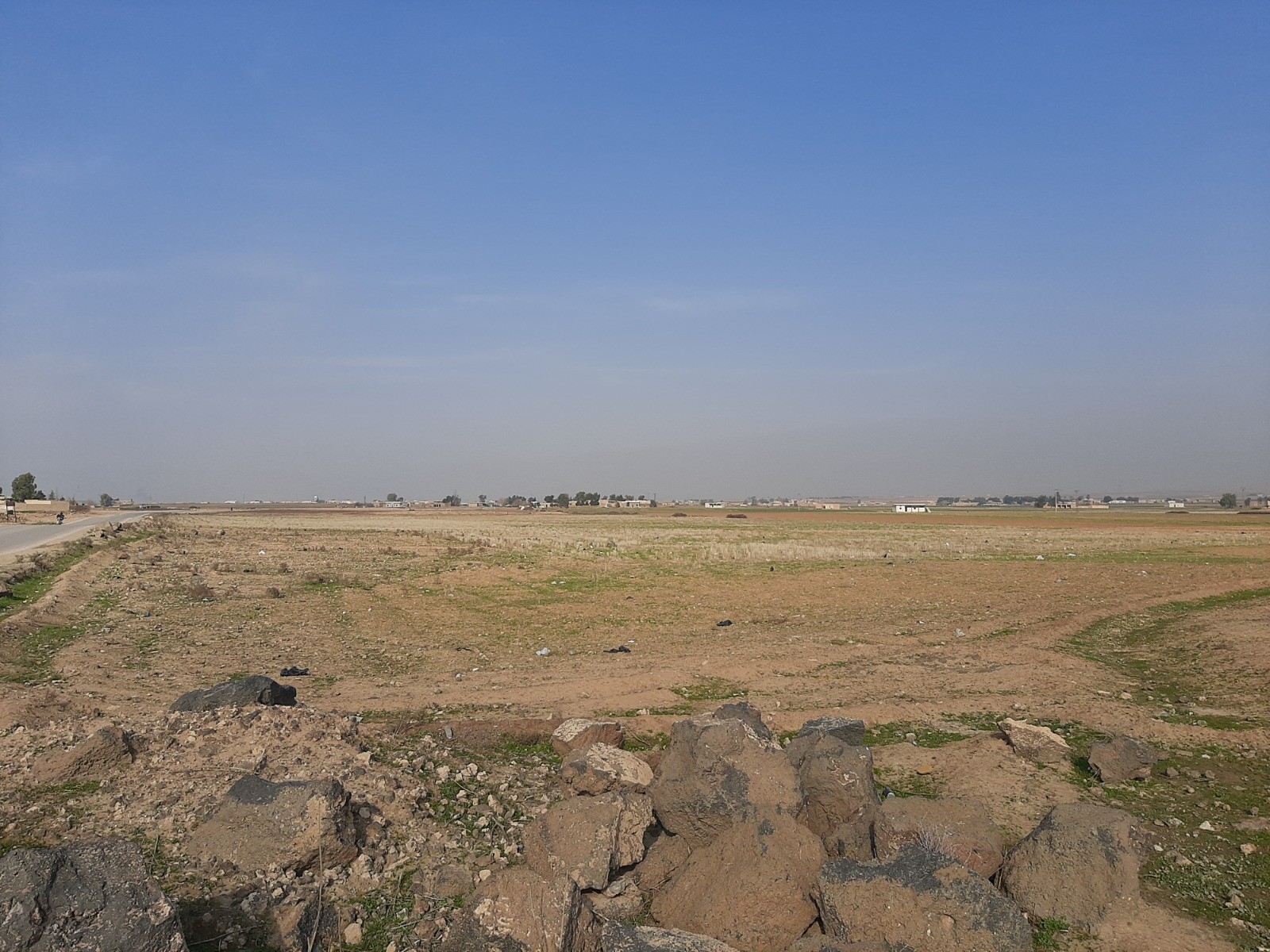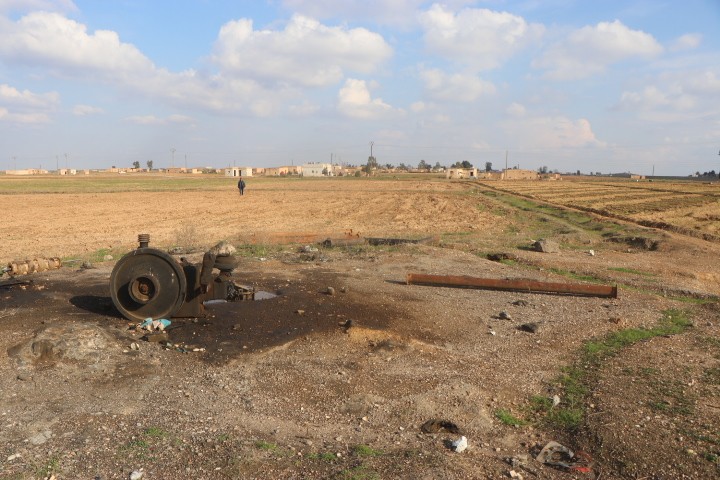Fuel crisis and weak subsidies threaten Syria’s northeastern bread basket
Farmers in northeastern Syria are reducing the amount of land they cultivate or relying on the rain for irrigation as weak fuel subsidies and high costs make farming increasingly unprofitable.
2 February 2024
HASAKAH — In al-Salaliya, a village eight kilometers from Syria’s northeastern Hasakah city, more than half of farmer Abed Allawi al-Muhammad’s land lies fallow. The 58-year-old farmer planted nothing there this year, instead sowing 70 of his 146 dunums of land with irrigated wheat.
“Nobody in the village has planted the entire area of their land, because of the fuel,” al-Muhammad told Syria Direct, displeasure clear on his face. “The price of black market fuel is sky-high, and the Autonomous Administration has not distributed a single liter of subsidized mazot [diesel] so far” this season.
Hasakah’s farmers began planting their land with irrigated wheat in October and November 2023. Al-Muhammad sowed his wheat in November. “The land needs irrigation 10 days after the seeds are scattered, so farmers need mazot during these two months,” he said. “They haven’t gotten it.”
Syria’s northeastern Jazira region—an area that includes land in Hasakah, Raqqa and Deir e-Zor provinces—has long been considered Syria’s “food basket,” growing strategic crops such as wheat, barley and cotton.
These crops are an essential source of income for local farmers, but growing them is “no longer profitable,” several told Syria Direct. High yearly agricultural costs, coupled with weak support from the Autonomous Administration of North and East Syria (AANES)—especially regarding fuel subsidies—are eating away at their livelihoods. Making matters worse, drought took a heavy toll on farmers from 2020 to 2022.
As a result, many Jazira farmers are reducing the area of their land they cultivate with irrigated crops and turning towards rain-fed farming. In addition to rain-fed wheat and barley, they choose aromatics such as cumin, cilantro and sesame, which cost less to grow.

Fallow farmland in northeastern Syria’s Hasakah province, 10/1/2024 (Salam Ali/Syria Direct)
The last growing season, in 2023, improved rainfall produced a relatively good wheat crop, compared to the previous years of drought. Still, Alaa Muhammad al-Allawi, 30, did not take the gamble of planting wheat on his 120 dunums of land this year. “Nobody can guarantee there will be enough rain, and the administration’s support won’t be enough to achieve good production,” he told Syria Direct.
Last year, al-Allawi lent out his land to another farmer to cultivate, in exchange for a portion of the crop. While rain brought more wheat, “the profits were small, compared to the high agriculture costs this year,” leaving him reluctant to plant it himself or lend it out again, he said.
In the eastern Hasakah countryside, Syria Direct observed large areas of uncultivated farmland left barren by its owners, who have not even planted less costly rain-fed crops. In Raqqa province, meanwhile, farmers said large areas have been converted to rain-fed farming, planted with crops such as lentils and cumin.
Growing one dunum of cumin costs around $31, split between $21 for three kilograms of seed and $10 for the cost of plowing the land. One dunum of wheat costs more than twice as much: SYP 1 million ($68.50 according to the current black market exchange rate of SYP 14,575 to the dollar).
The AANES’ plan
In November 2023, the AANES’ Agriculture and Irrigation Board issued its agricultural plan for 2024, which laid out the amount of seed per dunum it would provide farmers, as well as the desired crop ratios. The AANES body allocated 60 percent of farmland for irrigated wheat, five percent for barley, 15 percent for legumes and two percent for winter vegetables.
The AANES does not impose its agricultural plan on farmers in its areas of influence in northeastern Syria. Rather, the yearly plan is the basis for allocating support to farmers.. For example, if a farmer has 100 dunums of land, 60 dunums should be sown with irrigated wheat, according to the plan. If the farmer does not comply with the plan, the AANES will not provide support in the form of mazot, fertilizers and seeds beyond the percentage it specified.
However, the AANES is not following through with the support needed for its plan to be successfully implemented, a number of farmers in the Jazira region told Syria Direct. It is now the middle of the winter growing season, but the administration has not specified the amount or price of subsidized fuel for farmers.
One liter of market-rate mazot currently sells for SYP 4,500 ($0.31) in Hasakah province. In Raqqa, it reaches more than SYP 5,400 ($0.37).
Last season, the AANES allocated eight batches of 10-15 liters of mazot per dunum to be distributed throughout the growing season at a cost of SYP 410 per liter ($0.08 according to the exchange rate at the time of SYP 4,735 to the dollar). However, most farmers only received between three and five batches of fuel. In Raqqa, many farmers said they did not receive any. That season, one liter of black market mazot sold for SYP 1,500 ($0.31).
The AANES attributed delayed mazot distribution last season to the “great pressure” of farmers’ demand for fuel for irrigation due to scarce rainfall, as well as an increase in cultivated areas.
The explanation does not sit well with farmers. Al-Muhammad wondered: “If the AANES is suffering from a fuel shortage, where do the quantities sold on the black market come from?”
Farmers Syria Direct spoke to estimate that one dunum of land requires between 20 and 25 liters of mazot each time it is irrigated. For a good yield, the crop should be watered six-to-eight times per season.
Unsubsidized mazot eats profits
Wiping fuel and oil stains from his hands, Muhammad Ahmad recounted his struggles with farming, describing how an “unstable fuel subsidy” impacts growers, and, by extension, this crucial food-growing region.
Ahmad and his brothers own 450 dunums of land in al-Salaliya. This season, he planted 80 dunums of irrigated wheat, which he watered twice so far, using unsubsidized mazot and his family’s allocation of subsidized heating fuel.
Last season, the brothers planted 250 dunums of wheat, and received three out of the eight promised batches of subsidized mazot from the AANES, which provided 12 liters per dunum each time. However, they could not make the best use of the fuel, Ahmad said, because it came in the spring, after the crucial winter growing months had passed.
Without enough subsidized fuel, farmers like Ahmad rely on black market mazot and reduce the number of times they water their crops to cut costs. Many have resorted to using their allocations of heating fuel for irrigation, as he did this year.
Farmers use pumps to draw water from wells, which are run by mazot-powered generators. Fuel is essential for irrigation, and without it production is affected. When farmers have to buy it on the black market, farming becomes economically unsustainable.
Al-Muhammad bought 30 220-liter barrels of mazot from the black market this season, at a cost of SYP 800,000 ($55) each. So far, he has used 10 barrels to plow his land and irrigate it once. “If the recent amount of rain had not been good, I would have had to use larger quantities to water the land,” he said.
Abdul Karim Azzo, 35, a farmer from the eastern Hasakah countryside village of al-Sakhar, spent a total of SYP 12 million ($823) to buy 16 barrels of mazot this season. He could not risk the fate of his livelihood on subsidized AANES fuel, he said. Last season, he received three out of eight batches of mazot, and filled the gap through the black market.
This year, on top of buying black market fuel, Azzo reduced the cultivated area of his land, only planting 50 out of his 120 dunums. Last year, he planted 100 dunums.
Syria Direct reached out several times for an official response from Laila Saroukhan, co-chair of the AANES Agriculture and Irrigation Board, as well as the media officer at the AANES Economy Board, but received no response by the time of publication.
Oil infrastructure in northeastern Syria has been affected by Turkish military activity in recent months. In January, Turkish airstrikes in AANES-held territory damaged oil facilities and put some out of service, the co-chair of the General Administration of Oil and Fuels, Abeer Khalid, said in a statement on January 16. Any reduction in oil production affects fuel supplies for multiple sectors, including agriculture, while the full impact of the strikes is not immediately clear.
Relying on the rain
For the past two years, Ahmad Muhammad al-Hassan, a 32-year-old farmer in the town of Mazraat Tishreen, 30 kilometers north of Raqqa city, has not received his AANES fuel allowance. Instead, he is forced to buy what he needs from the black market, “reducing my profits,” he told Syria Direct.
At the start of the current season, al-Hassan bought 40 barrels of black market mazot for SYP 1.2 million ($82) per barrel, of which he has used 17 barrels to irrigate his land once. “If it doesn’t rain in a few days, I’ll have to water again,” he said.
Al-Hassan and his brothers own 1,000 dunums, all of it irrigated land, which they plant with a mixture of summer and winter crops. Due to “the exorbitant costs of buying fuel, we have reduced the crop area this year,” he said.
Last season, al-Hassan and his brothers planted 350 dunums with cotton, which they reduced to 100 dunums this year. They also cut the area of wheat from 500 dunums to 450, and of barley from 150 dunums to 80.
“Agriculture needs AANES support, and because of the fuel crisis, half the region’s land has become rain-fed, even though it is irrigated land with wells and canals,” Hassan said. Many farmers “have preferred to rent out their land instead of cultivating it, because they could not afford the costs.”
While rain-fed farming is less expensive, it is a gamble. The region’s climate is changing, with decreased rainfall and drying rivers. Agricultural production in Syria fell by “approximately 50 percent over the last 10 years,” Suhair Zaqout, the spokesperson for the International Committee of the Red Cross (ICRC) previously told AFP.
Looking out at his land in al-Salaliya, al-Muhammad hopes for plentiful rain this season. Enough of it would mean “good production, to make up for what I pay to buy the fuel, fertilizer and seeds, and plow, harvest and transport the crop.”
This report was originally published in Arabic and translated into English by Mateo Nelson.







